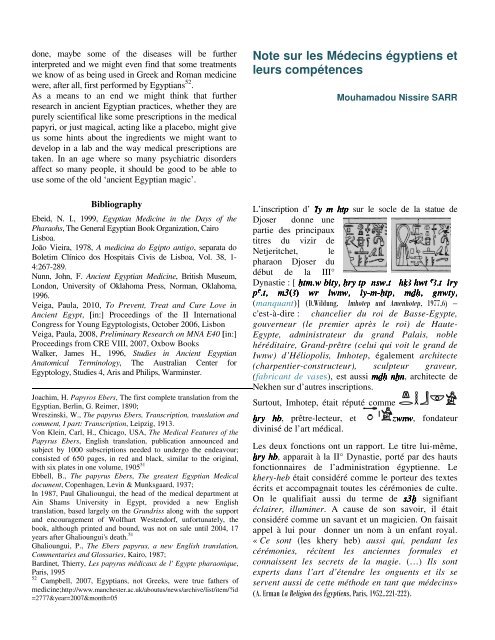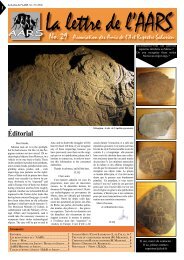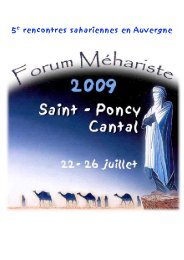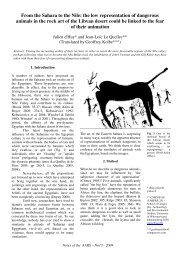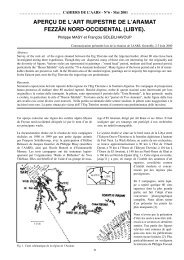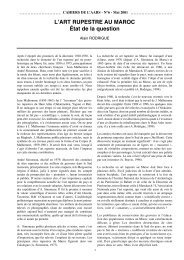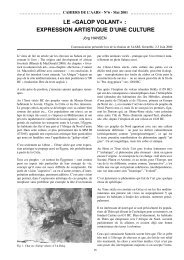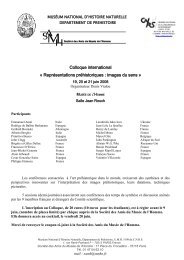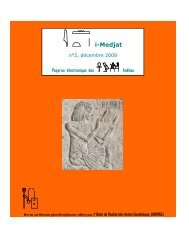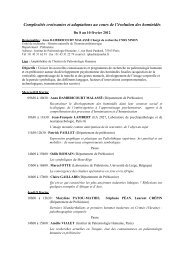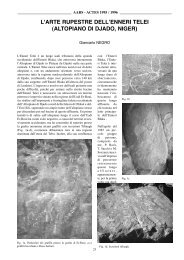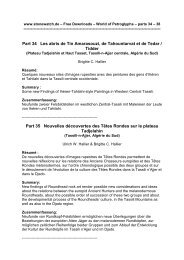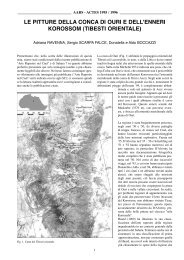i-Medjat - Culture Diff
i-Medjat - Culture Diff
i-Medjat - Culture Diff
You also want an ePaper? Increase the reach of your titles
YUMPU automatically turns print PDFs into web optimized ePapers that Google loves.
done, maybe some of the diseases will be further<br />
interpreted and we might even find that some treatments<br />
we know of as being used in Greek and Roman medicine<br />
were, after all, first performed by Egyptians 52 .<br />
As a means to an end we might think that further<br />
research in ancient Egyptian practices, whether they are<br />
purely scientifical like some prescriptions in the medical<br />
papyri, or just magical, acting like a placebo, might give<br />
us some hints about the ingredients we might want to<br />
develop in a lab and the way medical prescriptions are<br />
taken. In an age where so many psychiatric disorders<br />
affect so many people, it should be good to be able to<br />
use some of the old ‘ancient Egyptian magic’.<br />
Bibliography<br />
Ebeid, N. I., 1999, Egyptian Medicine in the Days of the<br />
Pharaohs, The General Egyptian Book Organization, Cairo<br />
Lisboa.<br />
João Vieira, 1978, A medicina do Egipto antigo, separata do<br />
Boletim Clínico dos Hospitais Civis de Lisboa, Vol. 38, 1-<br />
4:267-289.<br />
Nunn, John, F. Ancient Egyptian Medicine, British Museum,<br />
London, University of Oklahoma Press, Norman, Oklahoma,<br />
1996.<br />
Veiga, Paula, 2010, To Prevent, Treat and Cure Love in<br />
Ancient Egypt, [in:] Proceedings of the II International<br />
Congress for Young Egyptologists, October 2006, Lisbon<br />
Veiga, Paula, 2008, Preliminary Research on MNA E40 [in:]<br />
Proceedings from CRE VIII, 2007, Oxbow Books<br />
Walker, James H., 1996, Studies in Ancient Egyptian<br />
Anatomical Terminology, The Australian Center for<br />
Egyptology, Studies 4, Aris and Philips, Warminster.<br />
Joachim, H. Papyros Ebers, The first complete translation from the<br />
Egyptian, Berlin, G. Reimer, 1890;<br />
Wreszinski, W., The papyrus Ebers, Transcription, translation and<br />
comment, I part: Transcription, Leipzig, 1913.<br />
Von Klein, Carl, H., Chicago, USA, The Medical Features of the<br />
Papyrus Ebers, English translation, publication announced and<br />
subject by 1000 subscriptions needed to undergo the endeavour;<br />
consisted of 650 pages, in red and black, similar to the original,<br />
with six plates in one volume, 1905 51<br />
Ebbell, B., The papyrus Ebers, The greatest Egyptian Medical<br />
document, Copenhagen, Levin & Munksgaard, 1937;<br />
In 1987, Paul Ghalioungui, the head of the medical department at<br />
Ain Shams University in Egypt, provided a new English<br />
translation, based largely on the Grundriss along with the support<br />
and encouragement of Wolfhart Westendorf, unfortunately, the<br />
book, although printed and bound, was not on sale until 2004, 17<br />
years after Ghalioungui's death. 51<br />
Ghalioungui, P., The Ebers papyrus, a new English translation,<br />
Commentaries and Glossaries, Kairo, 1987;<br />
Bardinet, Thierry, Les papyrus médicaux de l' Egypte pharaonique,<br />
Paris, 1995<br />
52 Campbell, 2007, Egyptians, not Greeks, were true fathers of<br />
medicine;http://www.manchester.ac.uk/aboutus/news/archive/list/item/?id<br />
=2777&year=2007&month=05<br />
Note sur les Médecins égyptiens et<br />
leurs compétences<br />
Mouhamadou Nissire SARR<br />
L’inscription d’ Iy Iy m m htp htp sur le socle de la statue de<br />
Djoser donne une<br />
partie des principaux<br />
titres du vizir de<br />
Netjeritchet, le<br />
pharaon Djoser du<br />
début de la III°<br />
Dynastie : [ Htm.w Htm.w bity, bity, bity, Hry Hry tp tp nsw.t nsw.t hqA hwt aA.t aA.t iry<br />
pa.t, pa.t, m3(A) m3(A) wr wr iwnw, iwnw, iy iy-m-Htp, iy iy Htp, mDH, mDH, gnwty, gnwty,<br />
gnwty,<br />
(manquant)] (D.Wildung, Imhotep und Amenhotep, 1977,6) –<br />
c'est-à-dire : chancelier du roi de Basse-Egypte,<br />
gouverneur (le premier après le roi) de Haute-<br />
Egypte, administrateur du grand Palais, noble<br />
héréditaire, Grand-prêtre (celui qui voit le grand de<br />
Iwnw) d’Héliopolis, Imhotep, également architecte<br />
(charpentier-constructeur), sculpteur graveur,<br />
(fabricant de vases), est aussi mDH mDH nxn nxn, nxn architecte de<br />
Nekhen sur d’autres inscriptions.<br />
Surtout, Imhotep, était réputé comme<br />
Xry Xry hb hb, hb prêtre-lecteur, et zwnw wnw wnw, wnw fondateur<br />
divinisé de l’art médical.<br />
Les deux fonctions ont un rapport. Le titre lui-même,<br />
Xry Xry hb hb, hb apparait à la II° Dynastie, porté par des hauts<br />
fonctionnaires de l’administration égyptienne. Le<br />
khery-heb était considéré comme le porteur des textes<br />
écrits et accompagnait toutes les cérémonies de culte.<br />
On le qualifiait aussi du terme de s3x s3x signifiant<br />
éclairer, illuminer. A cause de son savoir, il était<br />
considéré comme un savant et un magicien. On faisait<br />
appel à lui pour donner un nom à un enfant royal.<br />
« Ce sont (les khery heb) aussi qui, pendant les<br />
cérémonies, récitent les anciennes formules et<br />
connaissent les secrets de la magie. (…) Ils sont<br />
experts dans l’art d’étendre les onguents et ils se<br />
servent aussi de cette méthode en tant que médecins»<br />
(A. Erman La Religion des Égyptiens, Paris, 1952,.221-222).


